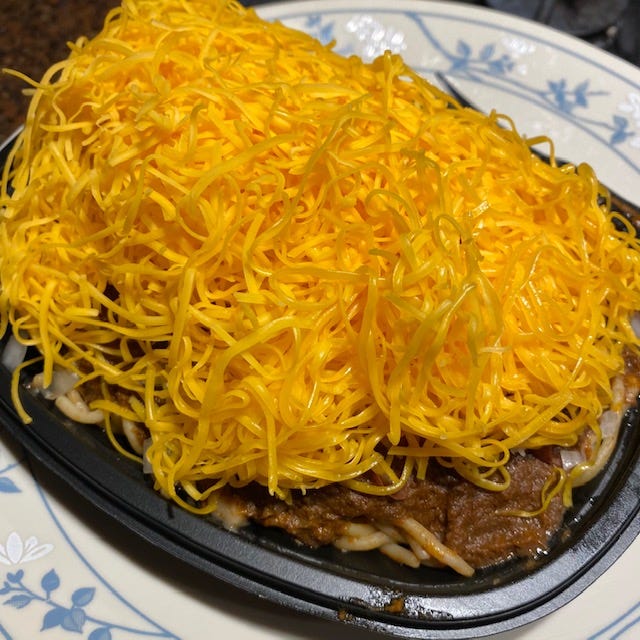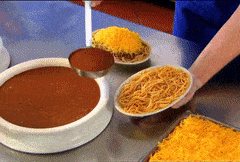If you want to make one person mad on the internet, start a conversation about chili.
If you want to make a lot of people mad on the internet, start a conversation about Cincinnati chili.
The dish, if you’re not familiar, consists of a thin meat sauce flavored with allspice, cinnamon, cloves and other spices reflecting its heritage, having been developed by Greek and Macedonian immigrants to the Ohio Valley in the early part of the 20th century. This sauce—and really, it’s more of a sauce than a chili—is served by pouring it over a plate of cooked spaghetti noodles, then topping it with red kidney beans and/or chopped white onions, followed by a large mound of finely-shredded sharp cheddar cheese. It’s an unusual presentation, no doubt, but once you get past the visual, it’s really quite a tasty dish.
You see? I just made a lot of people mad. Possibly even you!
Now, to be perfectly honest with you, I enjoy Cincinnati chili, but I know it’s weird. I didn’t grow up eating it, and only first experienced it when I moved to southwest Ohio’s premier city for my freshman year of college. I probably eat it four or five times a year, on those rare times I’m near one of the local outlets here in Louisville and in the proper mindset. But I’ve adopted it as a bit of a calling card, because it’s practically guaranteed to get a reaction out of people.
For instance, I often celebrate a big win by my Cincinnati Bearcats by posting this admittedly-unsettling GIF1 on Twitter:
People hate when I do this!
Now, it’s possible to have a legitimate aversion to Cincinnati chili; I can tell you from personal experience that I avoided it for several years following an unfortunate incident involving a large five-way, a Midnight Madness basketball event, and the ten or twelve beers I had before both. But, unscientifically, it seems the larger opposition comes from people who’ve never even tried the dish, and object on purely conceptual and/or semantic grounds.
It’s not CHILI. You’re putting CHILI on spaghetti? There’s no cinnamon in CHILI!
All fair points, really, but this is the hill you’re dying on?
If, a century ago, the Ohio Valley diner proprietors who popularized the dish had decided to call it Macedonian Bolognese or Southwest Ohio Gravy Noodles, would we even be having this conversation?
It’s not just Cincinnati chili, either. We see semantic debates like this erupt over what is good and proper and correct all over the place. Many a battle has been fought over Chicago-style deep dish pizza, a heavy, cheese-and-sauce laden dish that’s closer to a casserole than its Neapolitan namesake. St. Louis boasts a version with a crackery-thin crust topped with a special processed cheese blend unlike anything you’ll find on pizza anywhere else. Last year, a baffled tweet from my friend Bill DiFilippo spawned a minor internet to-do over the existence (or not) of something called “Altoona-style” pizza, and I can only imagine the reaction if some of the people reacting to that oddity were exposed to Steubenville, Ohio’s contribution to the flatbread discourse: pizza that’s topped after baking.
That’s all without even getting into barbecue, the American food most likely to launch a full-scale war. Regional foods are our foremost source of low-stakes internet argument, a chance to get mad about something other than politics or religion or sports, a chance to stake out a stance as a noble food purist, the rock-ribbed defender of You Can’t Put That Thing On That Thing.
Well, here’s my contrarian take, which I happen to also believe: all these things are good. All of them. St. Louis pizza? Good. Chicago-style hot dogs? Good. And if you put barbecue in front of me, I’ll at least give it a shot whether it’s from Texas, Kansas City, Memphis, Carolina, Kentucky or anywhere else. Is there a Minnesota-style barbecue? I don’t know! But if there is, I’d like to try it.
There’s very little that differentiates the American cultural landscape anymore. In an interconnected, mobile society, a lot of the regional oddities that gave places like Cincinnati or St. Louis or even Altoona a distinct local character have disappeared in only a few short generations. Outside of some diehard pockets in the mid-Atlantic, even many of the distinct regional accents have fallen away, in favor of a general urban-versus-rural divide in speech patterns.
Our food has trended toward a monoculture, too, as more and more we’re fed by large corporations with big, industrialized supply chains, and inspired to do our own cooking by the same trends, the same communication channels, the same cooking shows and beloved food blogs. There’s little opportunity for something to evolve in a bubble now, to be created because of what was on hand and what the people on hand knew how to do with it.2
These stubborn, dead-ender regional foods? They’re a reminder that the food we eat is actually made by people, and not handed down from a central kitchen with a clear set of standards. In a nation that can be deeply averse to any reminder of its actual, relatively-short history, these weird, semantically-divisive culinary aberrations betray our roots, let our accent slip, if only a little bit. It’s a chili-stained map to a past we’ve paved over in practically every other way, and a reminder that there’s still something delicious below that surface.
Also, Skyline Chili really is great if you’ve had a couple of beers.
Especially if you want to start an argument.
—Scott Hines (@actioncookbook)
I know that I’m going to get people yelling at me on Twitter, because when I tweet this I’m going to include a picture of Skyline Chili. That’s fine. What I’d like to hear from you is a regional oddity that you love. People are starting to travel again. What’s a weird, regional food that you think is worth defending?
Many people who are not enlightened to the ways of Skyline Chili often express confusion at the part of this GIF that depicts the application of hot sauce to an oyster cracker, and the explanation is simple: they’re the two things that are already on the table when you sit down, so you eat them while you wait for your chili. I appreciate the attention to detail demonstrated by including this in the GIF.
In this analogy, I believe that St. Louis is our culinary Galapagos Islands. Please do not ask me to flesh out this analogy.






Cincinnati chili is good, end of story!
Honestly, weird regional foods are everything that's great about America, since so many of them have their origins in immigrant communities attempting traditional/favorite dishes with different and new (and often more abundant) ingredients found in the US.